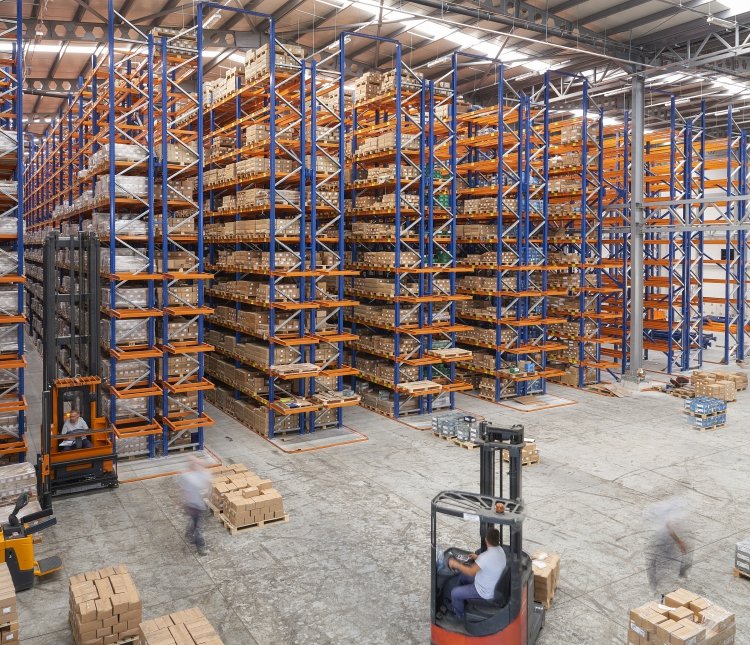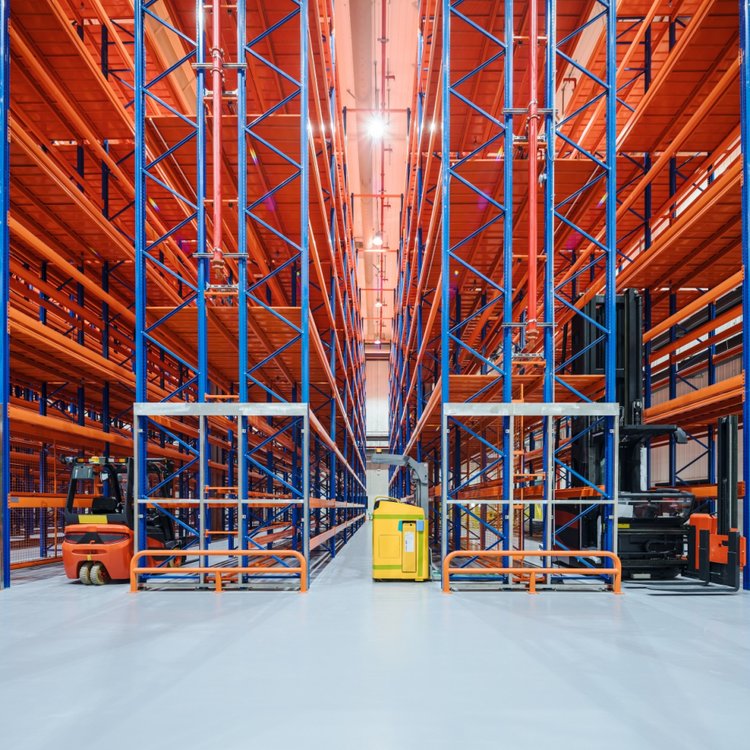Alright, warehouse warriors and logistics planners! Let's tackle a fundamental decision that can make or break your operation's efficiency and cost-effectiveness: Narrow Aisle Racking versus good ol' Standard Pallet Racking. This isn't just about where to stick your pallets; it's about unlocking serious space savings, optimizing workflow, and getting the most bang for your buck. Strap in, because we're diving deep into the pros, cons, and key considerations to help you pick the champion for your specific needs.
The Core Difference: It's All About That Aisle Space
Picture this: A standard warehouse setup. You've got rows and rows of pallet racking, with aisles wide enough for a standard counterbalance forklift to maneuver, turn, and lift. Those aisles? Typically need to be 11 to 13 feet wide, sometimes even more. That's a whole lot of real estate dedicated just to moving around, not storing product. That's Standard Racking.
Now, enter the space-saving hero: Narrow Aisle Racking. As the name screams, the whole point is to drastically shrink those aisles. We're talking aisles in the 6 to 8-foot range, sometimes even tighter. How is this magic possible? Specialized equipment – think narrow aisle forklifts (often called "turret trucks" or "man-up" order pickers) or Very Narrow Aisle (VNA) machines guided by rails or wires. These machines are designed for precision in tight spaces. Narrow Aisle Racking systems themselves are often built taller and may incorporate specific features like guided base rails to support this equipment.

The Big Kahuna: Space Utilization – Where Narrow Aisle Shines
Let's cut to the chase. The number one reason folks seriously consider Narrow Aisle Racking? Space. Savings. Period.
- Crunching the Numbers: By slashing aisle widths, you instantly free up significant square footage within your existing building. We're talking potential increases of 25% to 50% or more in your actual storage capacity. Imagine storing 10,000 pallets in a space where you could previously only fit 7,000 with standard racking. That's a game-changer.
- Going Vertical (Safely): Narrow Aisle Racking often pairs beautifully with higher clear buildings. Standard forklifts have height limitations based on their lift capacity and stability. Narrow aisle and VNA equipment, however, are specifically engineered for stability at greater heights. This means you can confidently build your Narrow Aisle Racking system taller – think 30, 40, even 50 feet or more – stacking more pallets vertically without expanding your building footprint. More cubic space utilized equals lower cost per pallet position.
- The Standard Reality: While perfectly functional, standard racking simply eats up more floor space per pallet stored due to those wide aisles. If your warehouse space is expensive (and whose isn't?), or if you're bursting at the seams, this inefficiency hits your bottom line hard. Expanding a building is massively costly; optimizing within it is smarter.
Equipment & Operation: The Heart of the Matter
You can't have Narrow Aisle Racking without the right gear and operators. This is where the rubber meets the road (or the wire guide).
- Narrow Aisle Needs Specialized Gear: Forget your standard counterbalance forklift. Operating effectively in a Narrow Aisle Racking setup requires:Narrow Aisle Forklifts (Turret Trucks/Order Pickers): These have forks that rotate 90 degrees (left and right) and the operator often rises with the load. This allows them to place and retrieve pallets perpendicularly while traveling straight down the narrow aisle. Maneuvering happens at the aisle ends.VNA (Very Narrow Aisle) Trucks: These take it further, working in aisles sometimes under 6 feet. They rely on guide rails or wires embedded in the floor for absolute precision steering. The operator always rises with the load, requiring excellent visibility systems.
- Cost & Complexity: Let's be real. This specialized equipment costs significantly more upfront than a standard forklift. Training requirements are also higher – operators need specific certification for these machines due to the unique handling and height capabilities. Maintenance can be more specialized and potentially pricier. Narrow Aisle Racking demands an investment in both the system and the people/machines running it.
- Standard Racking Simplicity: Here's the win for standard systems: flexibility. Standard counterbalance forklifts are ubiquitous, relatively affordable to buy or rent, and finding trained operators is generally easier. They can handle pallets inside the racking and perform loading/unloading tasks outside the warehouse – a single machine for multiple roles. Maneuvering within the aisles is more forgiving.
Cost Considerations: Upfront vs. Long-Term
This is where the decision gets nuanced. It's not just about the racking price tag.
- Narrow Aisle Racking System Costs: The racking structure itself for a Narrow Aisle Racking system might be similar per bay to robust standard racking designed for high heights. However, the real investment is elsewhere:Specialized Equipment: As mentioned, this is a major capital expenditure.Potential Building Modifications: Do you have the height? Is your floor flat and strong enough? Higher Narrow Aisle Racking might require reinforced concrete floors, which is a big cost if needed. VNA systems absolutely require guide rail installation.Training: Investing in skilled operators is non-negotiable.
- Standard Racking Costs: The racking structure is typically the primary cost. Equipment is cheaper and more versatile. Building requirements are usually less stringent unless going very high (which standard forklifts often can't handle safely anyway).
- The Long Game (ROI): This is crucial. While Narrow Aisle Racking has higher initial setup costs, the dramatic increase in storage density directly translates to lower cost per pallet position over the system's lifespan. If you're paying high rent per square foot, or facing costly expansion, the ROI on a Narrow Aisle Racking system can be compelling and rapid. Standard racking has lower upfront costs but higher ongoing "space cost" per pallet stored.
Productivity & Throughput: Speed vs. Density?
Which system gets goods moving faster? It depends on your workflow.
- Narrow Aisle Potential: In high-volume, high-SKU operations, Narrow Aisle Racking combined with the right equipment (like man-up order pickers) can enable faster order picking cycles. Operators travel less distance between picks within the aisle. However, travel to the aisle might be longer in a larger, denser footprint. VNA can be exceptionally fast for specific put-away/retrieval tasks in very dense environments.
- Standard Racking Reality: Standard forklifts can often travel faster down wider aisles. Maneuvering is quicker. For operations with fewer, larger movements (e.g., full pallet in/full pallet out), standard systems can be very efficient. Congestion can become a bigger issue in busy warehouses with wider aisles, though.
- The Congestion Factor: Narrow Aisle Racking inherently has fewer aisles. This can lead to congestion points at the ends of aisles if traffic isn't managed well. Standard racking has more aisles, potentially spreading out traffic, but each aisle takes up more space.

Making the Right Call: Key Decision Factors
So, how do you decide? Ask yourself these critical questions:
- How Precious is Your Space? Are you maxed out? Is expansion impossible or prohibitively expensive? Is your rent/lease cost sky-high? If "yes," Narrow Aisle Racking is screaming your name.
- What's Your Budget Reality? Can you stomach the higher upfront investment in equipment and potentially the racking/building mods? If capital is extremely tight right now, standard might be the necessary starting point, but calculate that long-term space cost!
- What's Your Product Profile & Flow?SKU Count: High SKU count often favors Narrow Aisle Racking for dense storage and efficient picking.Turnover: Fast-moving goods benefit from efficient picking paths enabled by narrow aisle setups. Slow-movers might not justify the investment.Pallet Size/Weight: Ensure your chosen Narrow Aisle Racking equipment can handle your max pallet dimensions and weight at the required heights.Handling Needs: Mostly full pallet moves? Or heavy order picking? This dictates the best equipment type (e.g., turret truck vs. order picker).
- What's Your Building Like?Clear Height: Got 30+ feet? Narrow Aisle Racking lets you exploit it. Stuck under 20 feet? Standard might suffice.Floor Condition & Strength: Narrow Aisle Racking, especially VNA, demands excellent, level floors. High systems need strong concrete. Assess this cost.Column Spacing: Can your building layout accommodate the longer runs typical of Narrow Aisle Racking?
- What About Your Operators? Do you have access to (or can you train) skilled operators for specialized equipment? What's the labor market like? Factor in training time and cost. Narrow Aisle Racking lives and dies by operator skill.
Implementation & Safety: Non-Negotiables
Whichever path you choose, especially with Narrow Aisle Racking, safety and professional implementation are paramount.
- Design is King: Never buy racking off a brochure. Engage experienced warehouse design engineers or reputable racking suppliers. They'll analyze your needs, product, building, and flow to design the optimal Narrow Aisle Racking or standard system. This includes seismic considerations if applicable.
- Professional Installation: This is structural. Get experts to install it correctly and safely. Don't cut corners.
- Rigorous Inspections & Maintenance: Implement a strict schedule for inspecting both racking and equipment. Narrow Aisle Racking systems, operating at height in tight spaces, demand extra vigilance for damage. Equipment maintenance must be top-notch.
- Operator Training & Culture: This is critical, especially for Narrow Aisle Racking. Operators must be thoroughly trained and certified on the specific equipment. Foster a strong safety culture where reporting damage or near-misses is encouraged. Pedestrian safety protocols are vital in any warehouse but especially with fast-moving narrow aisle equipment.
- Guides & Protectors: Narrow Aisle Racking must include robust column guards and often base rails to protect the structure from inevitable minor equipment contact. Aisle-end protectors are essential.
The Verdict: It Depends! (But Here's a Cheat Sheet)
There's no single "best" solution. The right choice hinges entirely on your unique warehouse operation, budget, building, and goals.
- Lean Heavily Towards Narrow Aisle Racking If:Space is your #1 constraint or cost.You have high clear height (30ft+).You handle a high number of SKUs.Order picking efficiency is critical.You can invest upfront for long-term ROI.You can support specialized equipment and training.
- Standard Racking Might Be the Better Fit If:You have ample, affordable space.Your clear height is limited (<25ft).Your operation involves mostly full-pallet in/out with fewer SKUs.Capital budget is extremely tight upfront.You need maximum equipment flexibility (one forklift does it all).Your building floor or column layout isn't ideal for narrow aisles.Operator skill/turnover is a major concern.
Wrapping It Up: Choose Wisely, Optimize Constantly
Choosing between Narrow Aisle Racking and Standard Pallet Racking is a strategic decision impacting your warehouse for years. Narrow Aisle Racking offers unparalleled storage density and space savings, transforming your existing footprint. However, it demands significant investment in specialized equipment, a suitable building, and skilled labor. Standard racking provides flexibility, lower initial costs, and simplicity but sacrifices valuable storage space.
Carefully weigh your space costs, throughput needs, product characteristics, building constraints, and budget. Consult with experienced warehouse designers and racking professionals. Don't just think about today; think about your growth trajectory over the next 5-10 years.
Whichever system you implement, prioritize safety, professional design/installation, rigorous maintenance, and ongoing operator training. The most efficient warehouse is a safe warehouse. Choose wisely, optimize constantly, and watch your operation reach its full potential!


 Wechat
Wechat
 Whatsapp
Whatsapp